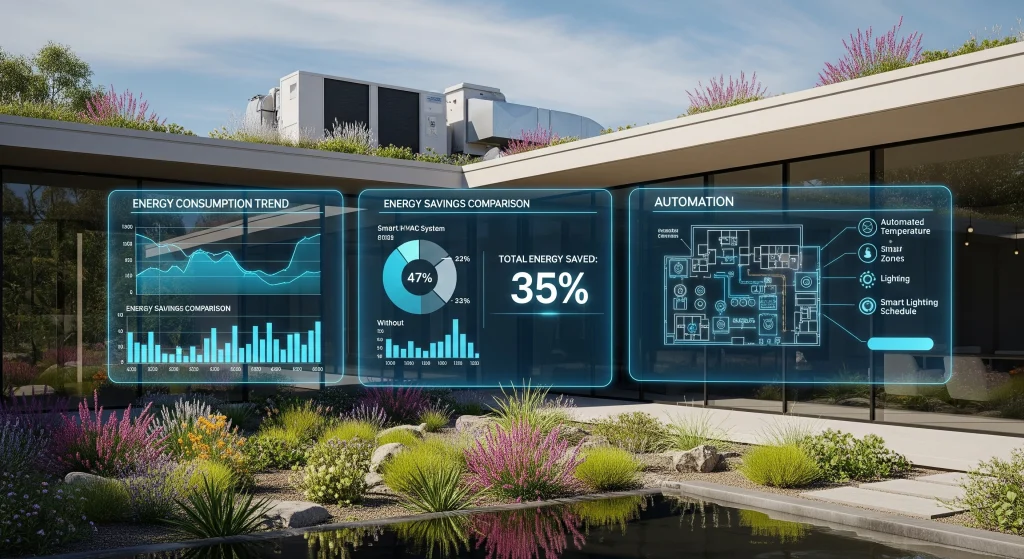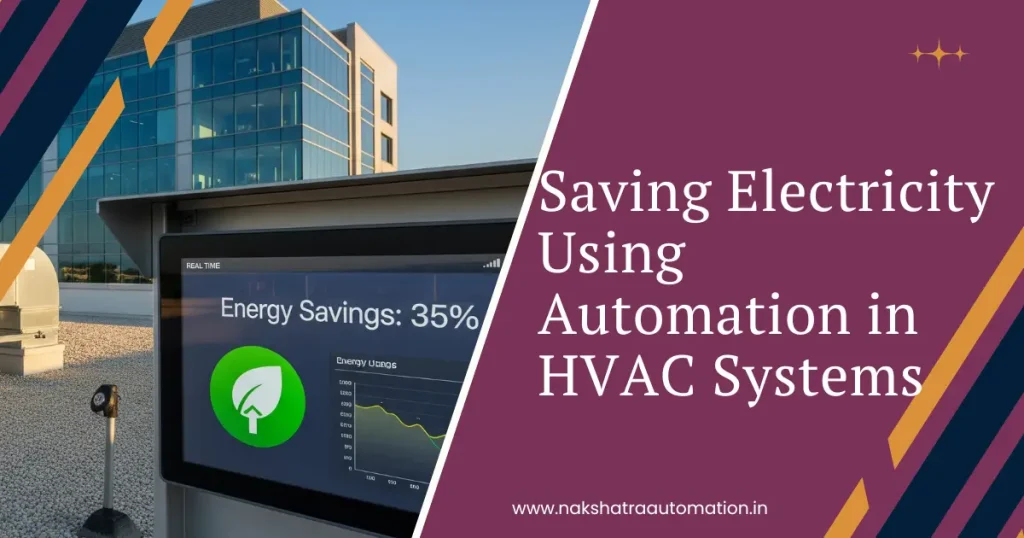
Heating, ventilation, and air conditioning (HVAC) systems are the largest consumers of electricity in residential, commercial, and industrial buildings. According to the U.S. Department of Energy, HVAC can account for 40–60% of total energy usage in a typical building. In hotter climates, this figure can be even higher.
The good news? With automation, HVAC systems can be transformed from energy guzzlers to intelligent, optimised systems that maximise comfort while minimising power consumption.
In this blog, we’ll explore how HVAC automation works, where energy is saved, and why every building—whether a smart home or a high-rise—should embrace this technology.
HVAC Automation
HVAC automation refers to using sensors, controllers, software, and smart algorithms to manage the operation of heating and cooling systems automatically.
It replaces outdated manual settings with systems that can:
- Monitor indoor and outdoor conditions
- Learn user behaviour and occupancy patterns
- Adjust operation in real-time to improve efficiency
This is typically implemented through a Building Management System (BMS) or Home Automation Platform.
Key Components of HVAC Automation
To understand how energy savings happen, let’s first look at the key components:
- Smart Thermostats – Adjust temperature based on schedules, occupancy, or real-time data.
- Temperature and Humidity Sensors – Feed accurate environmental data to control systems.
- Occupancy Sensors – Detect presence in rooms to optimise usage.
- Variable Speed Drives (VSDs) – Control fan and compressor speeds based on demand.
- Zone Controls – Allow for independent temperature settings in different areas.
- AI Algorithms – Learn patterns, weather forecasts, and usage habits to optimise performance.
- Integration with Other Systems – Coordinate with lighting, blinds, and access systems for maximum efficiency.
How Automation Saves Electricity in HVAC
Here’s how these automated technologies lead to real, measurable savings:
Smart Scheduling and Setback
Instead of running 24/7, HVAC systems follow smart schedules that match occupancy:
- Turn off or reduce AC/heating after office hours or when residents are away.
- Pre-cool or pre-heat spaces just before use.
- Use temperature setback during unoccupied periods (e.g., nighttime).
Energy savings: 10–30% by reducing runtime during low-use periods.
Demand-Based Cooling and Heating
Sensors continuously monitor real-time temperature, humidity, and occupancy. The system adjusts output only when necessary.
For example:
- If a room is unoccupied, the system can reduce airflow or shut off completely.
- If the outside temperature drops naturally, cooling can pause.
Energy savings: 15–25% by reducing unnecessary operations.
Zoning Control
Instead of conditioning the entire building equally, HVAC zoning allows different rooms or floors to have custom temperature settings.
- Cool conference rooms only during meetings.
- Heat bedrooms separately from the kitchen in a home.
Energy savings: 20–40% by conditioning only where needed.
Variable Speed Operation
Traditional HVAC units run at full capacity even for minor temperature adjustments. With variable speed fans and compressors, the system modulates output to match actual demand.
- Lower fan speed = less energy used
- Smooth operation avoids energy spikes
Energy savings: 10–20% by avoiding full-load cycles.
Free Cooling (Economiser Mode)
In buildings with automation, HVAC can use outside air for cooling when conditions allow.
- During cooler nights or seasons, the system can switch off compressors and use fresh air instead.
Energy savings: 5–15%, depending on local climate.
Integration with Lighting and Blinds
A truly smart building links HVAC with lighting and shading systems:
- Close motorised blinds during hot afternoons to reduce cooling load.
- Turn off HVAC in unoccupied zones when lights are off.
- Use daylight sensors to adjust cooling as sunlight changes.
Energy savings: 5–10% with integrated automation.
Predictive Maintenance and Diagnostics
Automated systems monitor equipment performance in real-time. Alerts are triggered when:
- Filters are clogged
- Coils are dirty
- Compressors are overworking
Fixing these issues early reduces energy waste and extends equipment life.
Energy savings: 5–10% through better equipment health.
Real-World Impact: Case Studies
- Smart Office Tower in Singapore reduced HVAC energy by 32% after implementing IoT sensors and centralised control.
- A large hotel chain in India saw a 20% drop in energy bills after implementing zoning and schedule-based automation.
- Smart Homes using thermostats like Nest or Ecobee report annual savings of 10–15% on HVAC electricity.
Getting Started: Steps to Automate HVAC
- Energy Audit – Analyse current HVAC performance and identify inefficiencies.
- Select Compatible Systems – Choose smart thermostats, sensors, and controllers that support integration.
- Install a Central Controller or BMS – For commercial buildings, a BMS ties all systems together.
- Define Rules and Schedules – Program logic based on occupancy, time, and usage patterns.
- Monitor and Optimise – Use analytics dashboards to refine performance over time.
The Future: AI-Driven HVAC Systems
The next evolution of HVAC automation is AI and machine learning:
- Systems learn from historical usage, weather patterns, and electricity pricing.
- They make micro-adjustments in real time for optimal performance.
- Integration with smart grids allows load shifting to cheaper, cleaner power sources.
In conclusion, HVAC automation is not just a luxury—it’s a necessity in the age of energy consciousness and climate responsibility. Whether you’re managing a home, office, school, or factory, smart HVAC systems offer:
- Lower electricity bills
- Enhanced comfort and air quality
- Longer equipment life
- Reduced carbon footprint
If your building still relies on manual thermostats and fixed-speed systems, it’s time for an upgrade. Automate, optimise, and breathe easy—both in comfort and in conscience.;
Ready to upgrade to smarter, more efficient HVAC? Contact Nakshatra Automation today to explore how our tailored solutions can save you money and energy.

